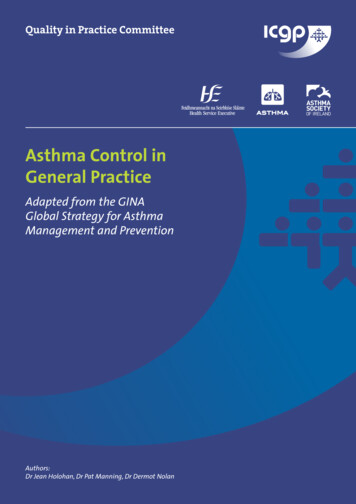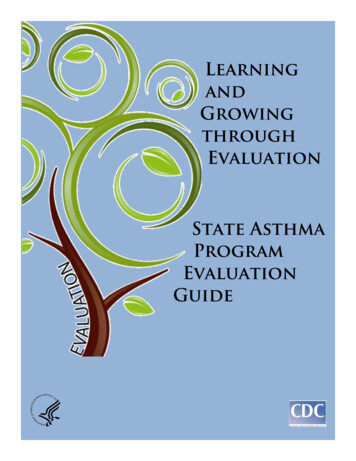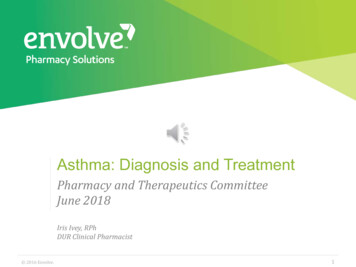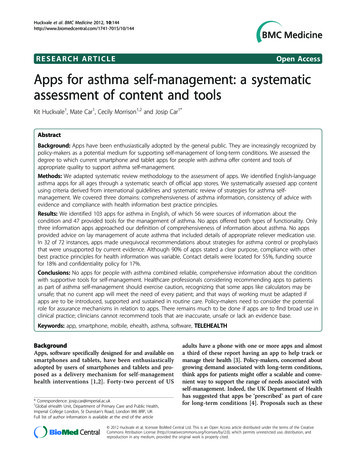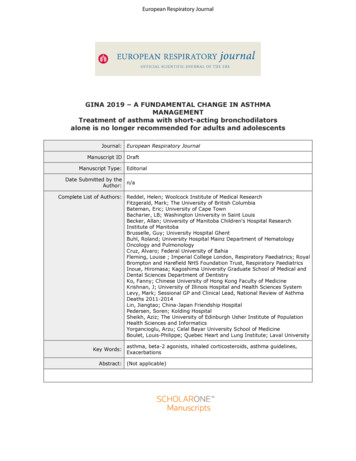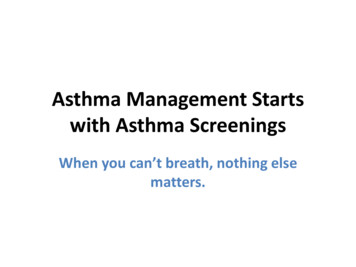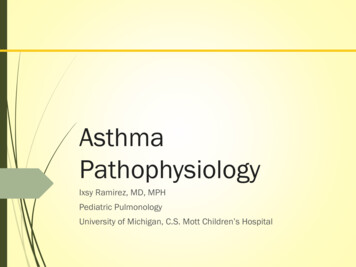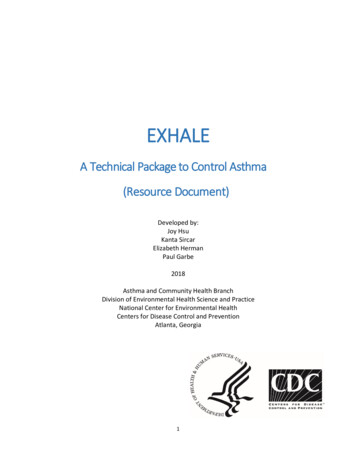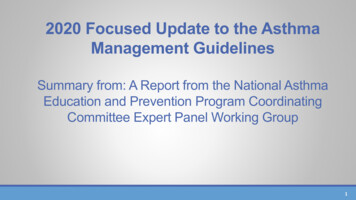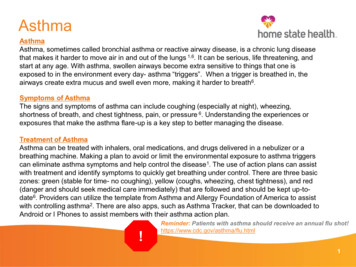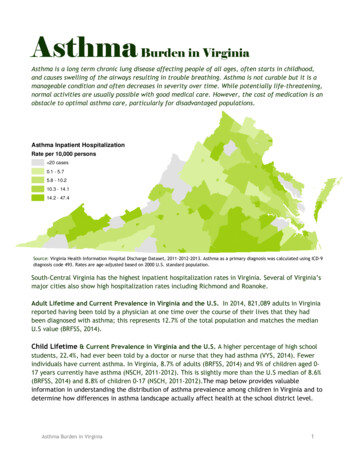
Transcription
Asthma Burden in VirginiaAsthma is a long term chronic lung disease affecting people of all ages, often starts in childhood,and causes swelling of the airways resulting in trouble breathing. Asthma is not curable but it is amanageable condition and often decreases in severity over time. While potentially life-threatening,normal activities are usually possible with good medical care. However, the cost of medication is anobstacle to optimal asthma care, particularly for disadvantaged populations.Asthma Inpatient HospitalizationRate per 10,000 persons 20 cases0.1 - 5.75.8 - 10.210.3 - 14.114.2 - 47.4Source: Virginia Health Information Hospital Discharge Dataset, 2011-2012-2013. Asthma as a primary diagnosis was calculated using ICD-9diagnosis code 493. Rates are age-adjusted based on 2000 U.S. standard population.South-Central Virginia has the highest inpatient hospitalization rates in Virginia. Several of Virginia’smajor cities also show high hospitalization rates including Richmond and Roanoke.Adult Lifetime and Current Prevalence in Virginia and the U.S. In 2014, 821,089 adults in Virginiareported having been told by a physician at one time over the course of their lives that they hadbeen diagnosed with asthma; this represents 12.7% of the total population and matches the medianU.S value (BRFSS, 2014).Child Lifetime & Current Prevalence in Virginia and the U.S. A higher percentage of high schoolstudents, 22.4%, had ever been told by a doctor or nurse that they had asthma (VYS, 2014). Fewerindividuals have current asthma. In Virginia, 8.7% of adults (BRFSS, 2014) and 9% of children aged 017 years currently have asthma (NSCH, 2011-2012). This is slightly more than the U.S median of 8.6%(BRFSS, 2014) and 8.8% of children 0-17 (NSCH, 2011-2012).The map below provides valuableinformation in understanding the distribution of asthma prevalence among children in Virginia and todetermine how differences in asthma landscape actually affect health at the school district level.Asthma Burden in Virginia1
Southwest and Southside Virginia arepredominantly rural areas and are the traditionalmining regions of the State. It has been known forthe past two and half decades as the mostmedically underserved areas of theCommonwealth. These regions have the highestrates of those below 200% FPL. With the largespread between 100% and 200% FPL; it isnoteworthy that lack of health insurance has bothimportant health and financial consequences.Health disparities across socioeconomic groupshave existed for many years but have recently received increasing attention from researchers, policymakers and the general public. National data (CDC) suggests that children between the ages of 5-11years have high asthma prevalence than the national average (10.6% vs 7.7%). However, AfricanAmerican children under the ages of 18years (13.4%) have almost twice the prevalence ratecompared to White children in the same age category (7.6%). For example, according to CDC, in2014, the asthma rate for persons living below 100% Federal Poverty Line (10.4 %) was higher thanany other poverty group.Asthma as an Economic Issue The cost of asthma for the U.S. was 56 billion in 2009; the cost peryear per child with asthma was over 1,000. In 2008, there were 10.5 million missed days of schooland 14.2 missed days of work across the U.S. due to asthma (CDC Asthma Impact, 2013). CDCestimates that in 2010 the medical and absenteeism costs in Virginia totaled 808 million dollars andestimates that in 2016 these total costs will be over 1.1 billion dollars yearly (CDC Cost Calculator).Asthma Trends Between 2011 and 2014, the lifetime and current prevalence of asthma has beenunchanged, ranging between 12.7 to 13.6% (lifetime) and 8.6 to 8.8% (current).Healthcare Utilization Patterns In the U.S., asthma as primary diagnosis accounted for 10.5 millionvisits to physician offices (NAMCS,2012). In 2014, there were 7,582admissions of Virginia residents toVirginia hospitals where the primarydiagnosis was asthma; the totalcharges for these cases was over 156million or an average of 20,600 percase; there is a marked differenceamong age groups for inpatienthospitalization, where there are twopeaks; children aged under 5 had thegreatest number of discharges amongyouth, with a second rise in casevolume peaking at the 45-54 agegroup.Source: Virginia Health Information Hospital Discharge Dataset, 2014. Asthmaas a primary diagnosis was calculated using ICD-9 diagnosis code 493.Asthma Burden in Virginia2
Hospitalization patterns differed among the basic categories of asthma and age groups, with chronicobstructive asthma affecting the older populations and unspecified asthma types affecting childrenunder age 17.Source: Virginia Health Information Hospital Discharge Dataset, 2014. Asthma as a primary diagnosis was calculated using ICD-9 diagnosiscodes 493.Socio-Demographics of Current Asthma in VirginiaAsthma affects women significantly more than it affects men, almost double the percent. Thedistribution of asthma by age is bimodal, with a peak in the youngest group and another peak inmiddle age (55-64). Black, non-Hispanic populations have the highest percent of current asthma, andHispanics have the lowest. Current asthma decreases with increased income and education. NorthernVirginia has lower prevalence compared with other regions.Source: Virginia Behavioral Risk Factor Surveillance System, 2014. Percents are weighted based on demographic and householdcharacteristics.Asthma Burden in Virginia3
Morbidity – Virginia Hospitalization RatesHospitalization rates among females are over 50% higher, reflecting the higher prevalence amongwomen. Hospitalization rates by age have two peaks, one in the under 1 year and 1 – 4 year agegroup, and a second peak starting in the 45-54 age group and increasing steadily across all remainingage groups. Non-Hispanic Blacks have a higher hospitalization rate compared to any other race.Source: Virginia Health Information Hospital Discharge Dataset, 2014. Asthma as a primary diagnosis was calculated using ICD-9 diagnosiscodes 493. Rates are age-adjusted based on 2000 U.S. standard population and are per 10,000 populations.Definitions Asthma: a chronic, long term lung disease that inflames and narrows the airways, resulting inwheezing, chest tightness, shortness of breath, and coughing; attacks or episodes are mostfrequent at night or early in the morning; both adults and children can develop asthma.Asthma attack (flare-up or exacerbation): sudden onset of asthma symptoms; when the airwaysreact, the muscles around them tighten, narrowing the airway, and mucus often is produced,which further narrows the airways.Intrinsic (non-allergic) asthma: a chronic, inflammatory disorder of the airways characterized bywheezing, breathing difficulties, coughing, chest tightness caused by inhalation of an irritant butnot caused by an allergic reaction; non-allergic asthma is triggered by other factors such asanxiety, stress, exercise, cold air, dry air, hyperventilation, smoke, viruses or other irritants. Innon-allergic asthma, the immune system is not involved in the reaction.Extrinsic (allergic) asthma: a chronic, inflammatory disorder of the airways characterized bywheezing, breathing difficulties, coughing, chest tightness, caused by an allergic reaction to aninhaled allergen from the environment; this is the most common type of asthma, caused byexternal materials which cause a response from the immune system in the form of an allergicreaction.Spirometry: a test for diagnosing asthma which evaluates lung function by measuring themaximum volume that can be exhaled after breathing in the maximum amount of air; measuresthe strength of the lungs related to the narrowing of airways caused by asthma.Asthma Burden in Virginia4
Risk Factors and Triggers Environmental risk factorsInherent Medical Triggers& triggers: both intrinsic& Risk FactorsAsthma Risk FactorsGender & Age(non-allergic) and extrinsicand TriggersRace & Ethnicity(allergic) asthma may beEducation levelIncome Leveltriggered by materials in theHeredity - family history ofBehavioralTriggers&environment which mayallergies, hay fever or eczemaRisk Factorseither cause irritation or anRespiratory infectionsTobaccoAspirin or other non-steroidal antiallergic reaction, resulting inExerciseinflammatory drugsAnxiety & Stressan asthma attack; theseinclude particulates such asEnvironmental Triggers & Risk Factorsdust, mold, pollen, smoke orAsthma AttackIrritants in Air & Air PollutionWheezing,animal hair and dander;Animal hair & dandershortness ofalternatively, chemicals inDustbreath, chestChemicals in air or foodtightness &the air may trigger attacksWeather changescoughingand may include airMold & PollenSecondary tobacco smokepollution, perfume and otherchemicals; finally, changesin temperature can trigger asthma attacks. Behavioral risk factors and triggers: smoking, exercise and heightened anxiety and stress maytrigger asthma attacks. Inherent risk factors and triggers: family history of allergies, hay fever or eczema maypredispose an individual towards asthma; in addition certain genders, age groups, racial groupsand ethnicities have higher asthma incidence; education and income levels are risk factors, aswell as medical conditions such as respiratory infections and use of certain medications.Description, Symptoms, Warning Signs and Diagnosis of Asthma Symptom Types: Asthma is a chronic inflammatory disease of the airways which is characterizedby two sets of symptoms:1. The bronchi (the airway branches leading to the lungs) become overly reactive and sensitiveto all kinds of triggers including allergens, cold air, dry air, smoke, viruses and other triggers;2. The lungs are unable to move air in and out, due to airflow obstruction;The combined effect results in coughing, wheezing, tight chest and other symptoms andconditions. Pattern of Asthma: Asthma is characterized by symptom-free periods with periodic attacks,although many people with asthma have some wheezing, shortness of breath and coughing at alltimes. Symptoms: The symptoms of asthma include:o Cough with or without sputum (phlegm) productiono Intercostal retractions – pulling in of the skin between the ribs when breathingo Shortness of breath that worsens with activityo Wheezing which often starts suddenly, may be episodic, increasing in the morning orevening, improves with bronchodilators and worsens when breathing cold air and withexercise. Emergency Symptoms – GO TO AN EMERGENCY ROOM if any of these symptoms occur: bluishcolor (face and lips, indicating insufficient oxygen), drowsiness or confusion, extreme difficultyAsthma Burden in Virginia5
breathing, rapid pulse, severe anxiety due to insufficient air; in addition an attack may becharacterized by abnormal, uneven breathing pattern, cessation of breathing, chest pain ortightness in the chest.Diagnosis of Asthma: a full battery of tests may be used to diagnose asthma and to differentiateit from other conditions; these include:o Evaluation of lung sounds using a stethoscope (wheezing, other lung sounds)o Allergy testing to identify allergenso Arterial blood gas test to determine levels of blood oxygeno Chest x-rayo Lung function testso Peak flow measurements to measure the ability of the lungs to expel airo Blood tests to measure eosinophil (white blood cell) and IgE (immunoglobulin) levels asidentifiers of immune response to allergensTreatment of Asthma – Treatment Plan and Medication:A combined approach using treatment planning and use of medication is necessary for the control ofasthma symptoms. The intent of asthma treatment is to reduce exposure to triggers and to controlthe swelling of the airways; treatment should always include the development of a written plan toeliminate the triggers, to monitor symptoms and to manage asthma attacks when they occur;medications may be used, and have two main functions: Control drugs: to prevent asthma attacks; these include beta-agonist inhalers to preventsymptoms and are often taken long term along with inhaled steroid medication. Rescue drugs: to provide rapid relief and to reduce the symptoms of an attack; these are takenat the time of an asthma attack to quickly reduce symptoms (when coughing, wheezing or havingtrouble breathing); can also be taken prior to exercise to prevent exercise-induced symptoms;these include bronchodilators or oral steroids. Other medications: additional medical care may be needed for severe asthma attacks thatcannot be controlled with rescue drugs and may include intravenous medications, oxygen,breathing assistance and other treatments.Impact of Asthma on Health: while there is no cure for asthma, proper medical care and selfmanagement can reduce the frequency and seriousness of asthma attacks. Key elements toprevention of asthma attacks involve avoidance of triggers: Use of “allergy-proof” casings for bedding Minimize use of carpets and rugs, and vacuum frequently Use only unscented cleaning materials Keep humidity low and reduce growth of organisms such as mold Reduce spread of cockroaches and other insects by keeping food in limited space, in kitchen Eliminate tobacco smoke from the home, including smoking of others, and even clothing withembedded smoke Avoid air pollution, industrial dust and fumesComplications of Asthma: Many people with asthma find that symptoms improve over time withreduced frequency of asthma attacks. However, there are potentially serious complications that maydevelop:Asthma Burden in Virginia6
Decreased ability to carry out activities of daily living including exerciseImpact on sleep due to attacks at night timeLong term reduction in lung functionPersistent coughDifficulty breathing, requiring use of a ventilatorDeathReferences:BRFSS - Virginia Department of Health (2014). Virginia Behavioral Risk Factor Surveillance System.Retrieved from brfss/VYS – Virginia Department of Health (2014). Virginia Youth Survey. Retrieved eys/youthsurvey/NSCH 2011-2012 – National Survey of Children's Health. Data query from the Child and AdolescentHealth Measurement Initiative, Data Resource Center for Child and Adolescent Health website.Retrieved from www.childhealthdata.orgCDC Asthma Impact – Centers for Disease Control and Prevention (2013). ASTHMA FACTS. Retrievedfrom http://www.cdc.gov/asthma/most recent data.htmCDC Cost Calculator - Centers for Disease Control and Prevention (2013). Chronic Disease CostCalculator Version 2.NAMCS - Centers for Disease Control and Prevention (2012). National Ambulatory Medical Care SurveyNIH National Heart, Lung and Blood Institute (2012). “What is Asthma?”. Retrieved asthma/Asthma and Allergy Foundation of America (2012). Asthma. Retrieved from www.aafa.orgUpdated: July 11, 2016Asthma Burden in Virginia7
Source: Virginia Health Information Hospital Discharge Dataset, 2011-2012-2013. Asthma as a primary diagnosis was calculated using ICD-9 diagnosis code 493. Rates are age-adjusted based on 2000 U.S. standard population. South-Central Virginia has the highest inpatient hospitalization rates in Virginia. Several of Virginia's
